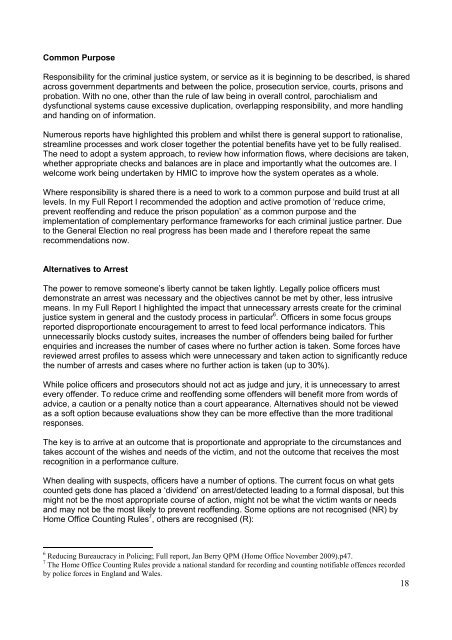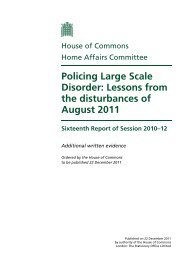Reducing Bureaucracy in Policing - Home Office
Reducing Bureaucracy in Policing - Home Office
Reducing Bureaucracy in Policing - Home Office
You also want an ePaper? Increase the reach of your titles
YUMPU automatically turns print PDFs into web optimized ePapers that Google loves.
Common Purpose<br />
Responsibility for the crim<strong>in</strong>al justice system, or service as it is beg<strong>in</strong>n<strong>in</strong>g to be described, is shared<br />
across government departments and between the police, prosecution service, courts, prisons and<br />
probation. With no one, other than the rule of law be<strong>in</strong>g <strong>in</strong> overall control, parochialism and<br />
dysfunctional systems cause excessive duplication, overlapp<strong>in</strong>g responsibility, and more handl<strong>in</strong>g<br />
and hand<strong>in</strong>g on of <strong>in</strong>formation.<br />
Numerous reports have highlighted this problem and whilst there is general support to rationalise,<br />
streaml<strong>in</strong>e processes and work closer together the potential benefits have yet to be fully realised.<br />
The need to adopt a system approach, to review how <strong>in</strong>formation flows, where decisions are taken,<br />
whether appropriate checks and balances are <strong>in</strong> place and importantly what the outcomes are. I<br />
welcome work be<strong>in</strong>g undertaken by HMIC to improve how the system operates as a whole.<br />
Where responsibility is shared there is a need to work to a common purpose and build trust at all<br />
levels. In my Full Report I recommended the adoption and active promotion of ‘reduce crime,<br />
prevent reoffend<strong>in</strong>g and reduce the prison population’ as a common purpose and the<br />
implementation of complementary performance frameworks for each crim<strong>in</strong>al justice partner. Due<br />
to the General Election no real progress has been made and I therefore repeat the same<br />
recommendations now.<br />
Alternatives to Arrest<br />
The power to remove someone’s liberty cannot be taken lightly. Legally police officers must<br />
demonstrate an arrest was necessary and the objectives cannot be met by other, less <strong>in</strong>trusive<br />
means. In my Full Report I highlighted the impact that unnecessary arrests create for the crim<strong>in</strong>al<br />
justice system <strong>in</strong> general and the custody process <strong>in</strong> particular 6 . <strong>Office</strong>rs <strong>in</strong> some focus groups<br />
reported disproportionate encouragement to arrest to feed local performance <strong>in</strong>dicators. This<br />
unnecessarily blocks custody suites, <strong>in</strong>creases the number of offenders be<strong>in</strong>g bailed for further<br />
enquiries and <strong>in</strong>creases the number of cases where no further action is taken. Some forces have<br />
reviewed arrest profiles to assess which were unnecessary and taken action to significantly reduce<br />
the number of arrests and cases where no further action is taken (up to 30%).<br />
While police officers and prosecutors should not act as judge and jury, it is unnecessary to arrest<br />
every offender. To reduce crime and reoffend<strong>in</strong>g some offenders will benefit more from words of<br />
advice, a caution or a penalty notice than a court appearance. Alternatives should not be viewed<br />
as a soft option because evaluations show they can be more effective than the more traditional<br />
responses.<br />
The key is to arrive at an outcome that is proportionate and appropriate to the circumstances and<br />
takes account of the wishes and needs of the victim, and not the outcome that receives the most<br />
recognition <strong>in</strong> a performance culture.<br />
When deal<strong>in</strong>g with suspects, officers have a number of options. The current focus on what gets<br />
counted gets done has placed a ‘dividend’ on arrest/detected lead<strong>in</strong>g to a formal disposal, but this<br />
might not be the most appropriate course of action, might not be what the victim wants or needs<br />
and may not be the most likely to prevent reoffend<strong>in</strong>g. Some options are not recognised (NR) by<br />
<strong>Home</strong> <strong>Office</strong> Count<strong>in</strong>g Rules 7 , others are recognised (R):<br />
6 <strong>Reduc<strong>in</strong>g</strong> <strong>Bureaucracy</strong> <strong>in</strong> Polic<strong>in</strong>g; Full report, Jan Berry QPM (<strong>Home</strong> <strong>Office</strong> November 2009).p47.<br />
7 The <strong>Home</strong> <strong>Office</strong> Count<strong>in</strong>g Rules provide a national standard for record<strong>in</strong>g and count<strong>in</strong>g notifiable offences recorded<br />
by police forces <strong>in</strong> England and Wales.<br />
18

















